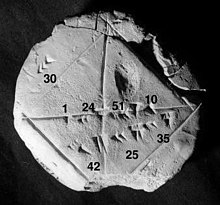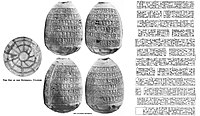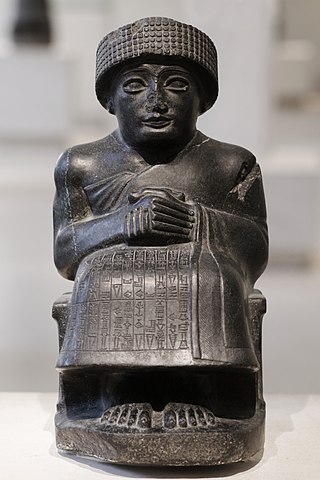
The history of Sumer spans the 5th to 3rd millennia BCE in southern Mesopotamia, and is taken to include the prehistoric Ubaid and Uruk periods. Sumer was the region's earliest known civilization and ended with the downfall of the Third Dynasty of Ur around 2004 BCE. It was followed by a transitional period of Amorite states before the rise of Babylonia in the 18th century BCE.

Sippar was an ancient Near Eastern Sumerian and later Babylonian city on the east bank of the Euphrates river. Its tell is located at the site of modern Tell Abu Habbah near Yusufiyah in Iraq's Baghdad Governorate, some 69 km (43 mi) north of Babylon and 30 km (19 mi) southwest of Baghdad. The city's ancient name, Sippar, could also refer to its sister city, Sippar-Amnanum ; a more specific designation for the city here referred to as Sippar was Sippar-Yahrurum.

Lagash, was an ancient city state located northwest of the junction of the Euphrates and Tigris rivers and east of Uruk, about 22 kilometres (14 mi) east of the modern town of Al-Shatrah, Iraq. Lagash was one of the oldest cities of the Ancient Near East. The ancient site of Nina is around 10 km (6.2 mi) away and marks the southern limit of the state. Nearby Girsu, about 25 km (16 mi) northwest of Lagash, was the religious center of the Lagash state. Lagash's main temple was the E-ninnu at Girsu, dedicated to the god Ningirsu. Lagash seems to have incorporated the ancient cities of Girsu, Nina, Uruazagga and Erim.

The Old Babylonian Empire, or First Babylonian Empire, is dated to c. 1894 BC – c. 1595 BC, and comes after the end of Sumerian power with the destruction of the Third Dynasty of Ur, and the subsequent Isin-Larsa period. The chronology of the first dynasty of Babylonia is debated, since there is a Babylonian King List A and also a Babylonian King List B. In this chronology, the regnal years of List A are used due to their wide usage. The reign lengths given in List B are longer, generally speaking.

Mesannepada, Mesh-Ane-pada or Mes-Anne-pada was the first king listed for the First Dynasty of Ur on the Sumerian king list. He is listed to have ruled for 80 years, having overthrown Lugal-kitun of Uruk: "Then Unug (Uruk) was defeated and the kingship was taken to Urim (Ur)". In one of his seals, found in the Royal Cemetery at Ur, he is also described as king of Kish.

Adab or Udab was an ancient Sumerian city between Telloh and Nippur. It was located at the site of modern Bismaya or Bismya in the Wasit Province of Iraq.

The Proto-Elamite period, also known as Susa III, is a chronological era in the ancient history of the area of Elam, dating from c. 3100 BC to 2700 BC. In archaeological terms this corresponds to the late Banesh period. Proto-Elamite sites are recognized as the oldest civilization in the territory of present-day Iran.
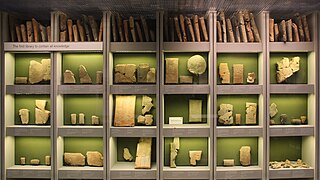
The Royal Library of Ashurbanipal, named after Ashurbanipal, the last great king of the Assyrian Empire, is a collection of more than 30,000 clay tablets and fragments containing texts of all kinds from the 7th century BCE, including texts in various languages. Among its holdings was the famous Epic of Gilgamesh.
Abī-Ešuḫ was the 8th king of the 1st Dynasty of Babylon and reigned for 28 years from c. 1648–1620 BC or 1711–1684 BC. He was preceded by Samsu-iluna, who was his father.

Entemena, also called Enmetena, lived circa 2400 BC, was a son of En-anna-tum I, and he reestablished Lagash as a power in Sumer. He defeated Il, king of Umma, in a territorial conflict, through an alliance with Lugal-kinishe-dudu of Uruk, successor to Enshakushanna, who is in the king list. The tutelary deity Shul-utula was his personal deity. His reign lasted at least 19 years.
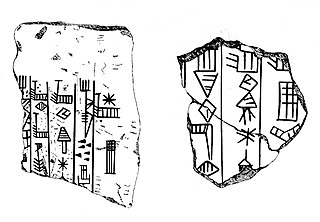
Enshakushanna, or Enshagsagana, En-shag-kush-ana, Enukduanna, En-Shakansha-Ana, En-šakušuana was a king of Uruk around the mid-3rd millennium BC who is named on the Sumerian King List, which states his reign to have been 60 years. He conquered Hamazi, Akkad, Kish, and Nippur, claiming hegemony over all of Sumer.

YBC 7289 is a Babylonian clay tablet notable for containing an accurate sexagesimal approximation to the square root of 2, the length of the diagonal of a unit square. This number is given to the equivalent of six decimal digits, "the greatest known computational accuracy ... in the ancient world". The tablet is believed to be the work of a student in southern Mesopotamia from some time between 1800 and 1600 BC.

Mesilim, also spelled Mesalim, was lugal (king) of the Sumerian city-state of Kish.
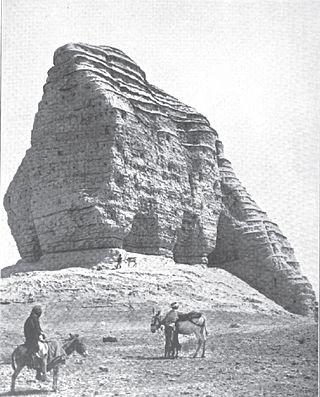
Kurigalzu I, usually inscribed ku-ri-gal-zu but also sometimes with the m or d determinative, the 17th king of the Kassite or 3rd dynasty that ruled over Babylon, was responsible for one of the most extensive and widespread building programs for which evidence has survived in Babylonia. The autobiography of Kurigalzu is one of the inscriptions which record that he was the son of Kadašman-Ḫarbe. Galzu, whose possible native pronunciation was gal-du or gal-šu, was the name by which the Kassites called themselves and Kurigalzu may mean Shepherd of the Kassites.

Uhub, , was Ensi (Governor) of the Sumerian city-state of Kish before Mesilim

IM 67118, also known as Db2-146, is an Old Babylonian clay tablet in the collection of the National Museum of Iraq that contains the solution to a problem in plane geometry concerning a rectangle with given area and diagonal. In the last part of the text the solution is proved correct by means of the Pythagorean theorem. The steps of the solution are believed to represent cut-and-paste geometry operations involving a diagram from which, it has been suggested, ancient Mesopotamians might, at an earlier time, have derived the Pythagorean theorem.
Lagaba was a city in the historical region of southern Mesopotamia. It is the place of origin of many illicitly excavated clay tablets, all in Old Babylonian. More than 400 tablets are known to have originated there. Tablets from Lagaba are kept in various collections around the world, among which
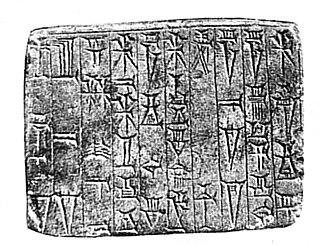
Sîn-gāmil was a king of Uruk during the 18th century BCE, at the time of the Isin-Larsa period. He was the son of Sîn-irībam, and Ilum-gāmil, his brother succeeded him.

Lugal-kinishe-dudu also Lugal-kiginne-dudu , was a King and (ensi) of Uruk and Ur who lived towards the end of the 25th century BCE. The Sumerian King List mentions Lugal-kinishe-dudu as the second king of the dynasty after En-shakansha-ana, attributing to him a fanciful reign of 120 years.

Enannatum II, son of Entemena, was Ensi (governor) of Lagash.

